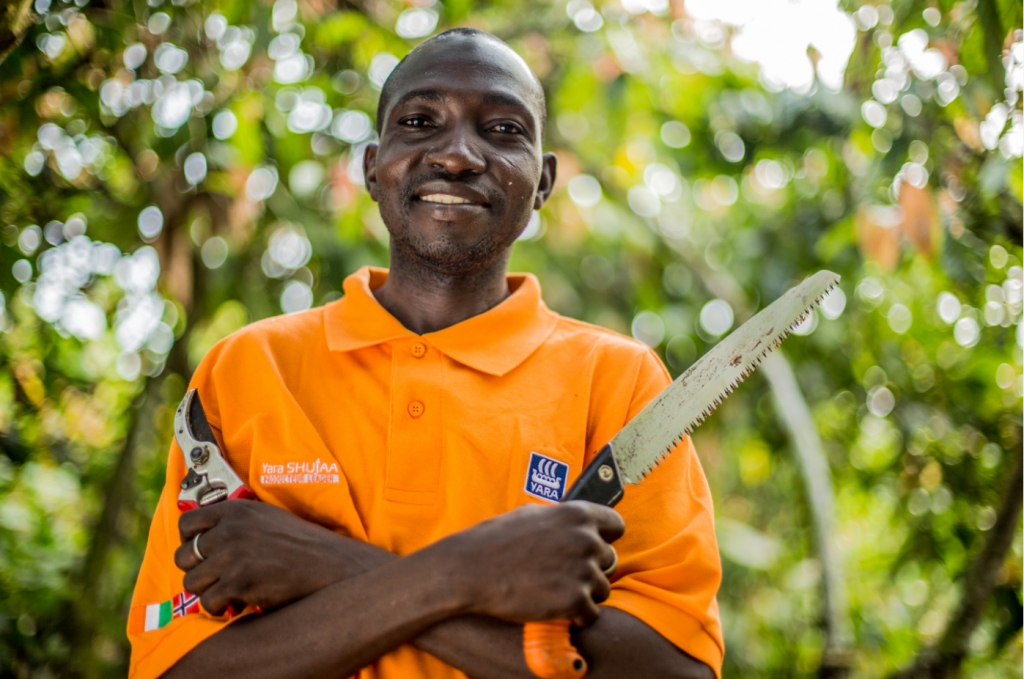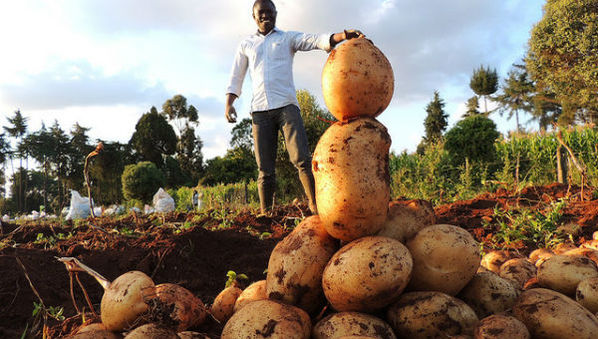Agriculture is instrumental in Africa’s poverty: it must also be instrumental in its wealth. Only through agricultural regeneration can growth, diversification and job creation occur for African economies, for no region of the world has ever industrialised without the agricultural sector being first transformed.
In short, the future of Africa depends on agriculture. But Africa cannot develop quickly if farming remains largely a subsistence activity. 60% of the population are involved in farming, yet it accounts for less than one seventh of its GDP, and African agricultural yield is the lowest in the world.

A farmer weeding his maize garden. Between $30 and $40 billion a year over the next ten years is needed to transform African agriculture and create the vibrancy.
So Africa is late in developing but even this very fact offers a large scale opportunity for international investors and big-ticket entrepreneurs.
Economic diversification and lasting wealth creation begins with a vibrant agriculture sector. Between $30 and $40 billion a year over the next ten years is needed to transform African agriculture and create the vibrancy. It’s a lot of money, but it is available, even within Africa, if the projects are good enough.
And they ought to be good enough, since such investments will create new markets worth at least $85 billion per year in added revenue by 2025. That’s a potential return of at least 100%. But which producers will own, influence and leverage these markets? Most, surely, should be made in Africa? We must own our development. The commitments of last year’s AGRF gave us a flying start with $30 billion over 10 years.
And with such transformation would come the reduction of Africa’s net trade deficit in food, potentially bringing net savings of up to $100 billion per year. We must bring an end to the costly and damaging anomaly of the net deficit in food. No more should Africa produce what it does not or cannot consume, and no more should it consume what it does not (but could easily) produce.
Other related measures would deliver similarly impressive albeit incalculable financial impacts: fiscal inclusion, tax reform, domestic revenue mobilization, higher remittances, reduced corruption and better governance.
There are also still huge and unexploited growth opportunities in Africa. The continent is endowed with 65% of the world’s uncultivated arable land and huge reserves of water. Sub Saharan Africa also has 10% of the world’s oil reserves, 40% of its gold, and up to 90% of its chromium and platinum. And those are just the known reserves – the whole continent is one of the world’s largest unexplored resource basins. Africa may suffer from poverty but it is an unimaginably rich continent, even after fifty years and more of commodity exploitation.
But how to bring about this transformation? How to close this potential deal of the century? Public and private sector should be acting together. They are needed to provide significant opportunities for Africa’s emerging innovators and entrepreneurs, not to mention its financiers, fund managers and financial advisers.
Over the past few years, the Bank has been able to bring about a comprehensive re-evaluation of the potentially enormous role of agriculture in the transformation of Africa, and the AGRF has been a critical factor in the shared objective with the Bank of bringing about the green revolution in Africa.
The technologies to feed Africa exist already. This is the period of climate change. High yielding drought-tolerant maize can allow farmers to grow a good crop even during droughts. Some cassava varieties can yield 80 tonnes per hectare. High yielding rice varieties that meet or beat international standards of imported rice now exist. Orange-fleshed sweet potatoes allow us to address the problem of vitamin A deficiency. Tropical and drought-tolerant wheat varieties are being grown in Nigeria, Kenya and Sudan.
These technologies need to be scaled up for widespread adoption. This will not happen by itself. It will require specific incentives. In particular, the African Development Bank and the World Bank plan to jointly provide $800 million through “Technologies for African Agricultural Transformation”, a flagship programme for the scaling up of agricultural technologies to reach millions of farmers in Africa over the next ten years.
For agricultural transformation more generally, the African Development Bank has committed $24 billion to agriculture over the next 10 years, with a sharp focus on food self-sufficiency and agro-industrialization.
It’s also why we launched the Affirmative Finance Action for Women in Africa (AFAWA), to make an extra $3 billion available for women entrepreneurs, in order to improve food production levels on the basis that women are demonstrably more dependable and bankable than men.
Getting our youth involved in agriculture as a business is crucial. That is why the Bank launched the ENABLE Youth program. This program will provide access to capital and capacity to “Agripreneurs” to create about 300,000 agribusinesses and 1.5 million jobs in 30 countries across Africa, with an estimated investment of $15 billion over the next five years.
With so many entrepreneurs now on the case of farming, an issue to resolve quickly is the current low level of commercial financing for agriculture. Finance and farming have not been easy partners in Africa, and the farming sector receives less than 3% of the overall financing provided by the banking sector.
The African Development Bank is promoting national risk sharing facilities in every country to leverage agricultural finance, similar to the Nigeria Incentive-Based Risk Sharing for Agricultural Lending (NIRSAL), a facility designed to reduce the risks of lending to Nigerian agriculture value chains. The impact in Nigeria was massive. Over four years, 15 million farmers were reached, 2.5 million of them women. Food production expanded by over 21 million tonnes. Today, several African countries are adopting the approach, as well as others such as Afghanistan.
I predict that the next few years will see agriculture emerge fully from poverty and subsistence to become the next big booming business sector of Africa, with entrepreneurs, financiers, inventors and innovators all gathering round a honey pot of bankable projects, programmes and opportunities. After all, who eats copper? And who drinks oil? Africans need to become producers and creators, and not just consumers, in the fast-moving enterprising business of food.
The African Development Bank will play its active role as a catalyst of this activity, and I am confident that we will soon see Africa’s first tranche of billionaires coming from the farming and food sectors.
Dr Akinwumi A. Adesina, President of the African Development Bank. He authored this op-ed ahead of the African Green Revolution Forum
Write comment (0 Comments)


















